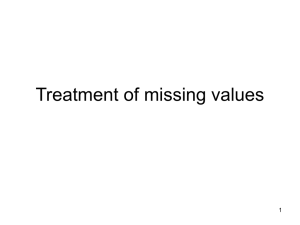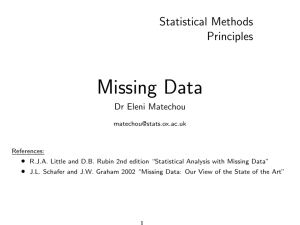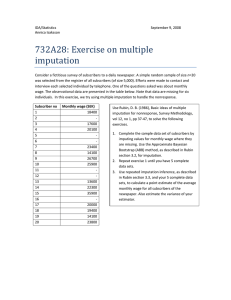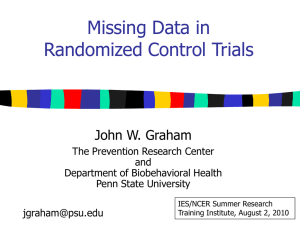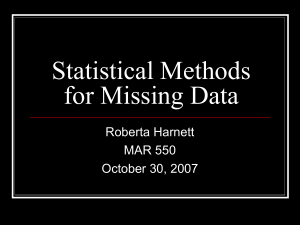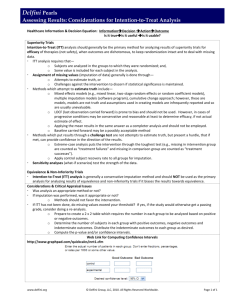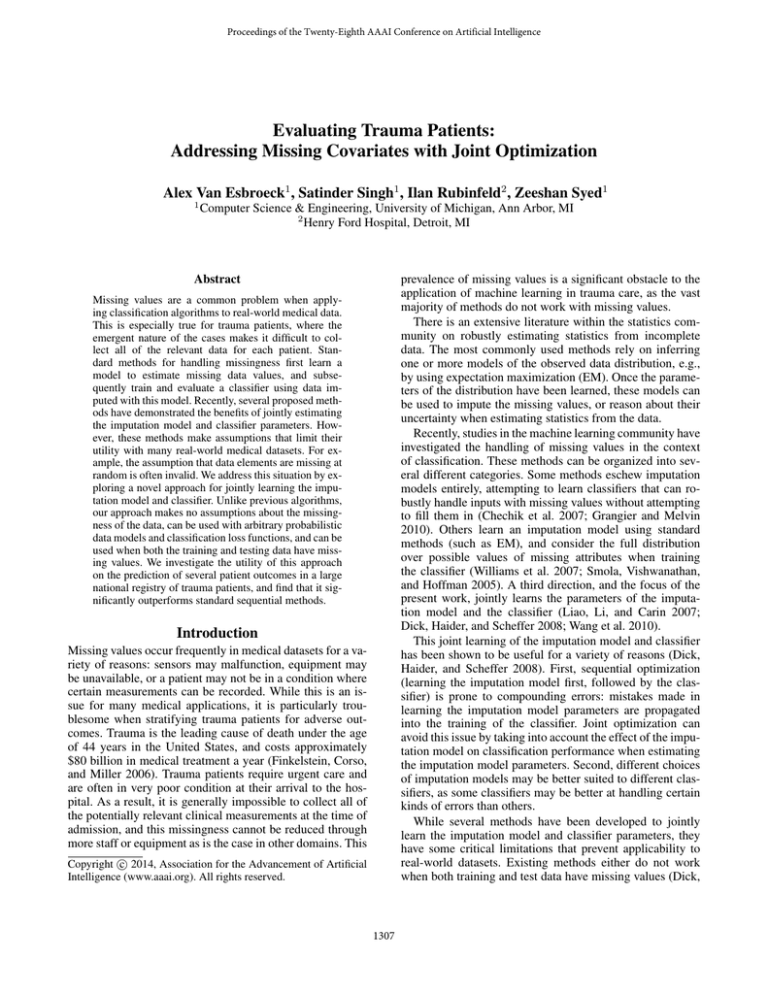
Proceedings of the Twenty-Eighth AAAI Conference on Artificial Intelligence
Evaluating Trauma Patients:
Addressing Missing Covariates with Joint Optimization
Alex Van Esbroeck1 , Satinder Singh1 , Ilan Rubinfeld2 , Zeeshan Syed1
1
Computer Science & Engineering, University of Michigan, Ann Arbor, MI
2
Henry Ford Hospital, Detroit, MI
Abstract
prevalence of missing values is a significant obstacle to the
application of machine learning in trauma care, as the vast
majority of methods do not work with missing values.
There is an extensive literature within the statistics community on robustly estimating statistics from incomplete
data. The most commonly used methods rely on inferring
one or more models of the observed data distribution, e.g.,
by using expectation maximization (EM). Once the parameters of the distribution have been learned, these models can
be used to impute the missing values, or reason about their
uncertainty when estimating statistics from the data.
Recently, studies in the machine learning community have
investigated the handling of missing values in the context
of classification. These methods can be organized into several different categories. Some methods eschew imputation
models entirely, attempting to learn classifiers that can robustly handle inputs with missing values without attempting
to fill them in (Chechik et al. 2007; Grangier and Melvin
2010). Others learn an imputation model using standard
methods (such as EM), and consider the full distribution
over possible values of missing attributes when training
the classifier (Williams et al. 2007; Smola, Vishwanathan,
and Hoffman 2005). A third direction, and the focus of the
present work, jointly learns the parameters of the imputation model and the classifier (Liao, Li, and Carin 2007;
Dick, Haider, and Scheffer 2008; Wang et al. 2010).
This joint learning of the imputation model and classifier
has been shown to be useful for a variety of reasons (Dick,
Haider, and Scheffer 2008). First, sequential optimization
(learning the imputation model first, followed by the classifier) is prone to compounding errors: mistakes made in
learning the imputation model parameters are propagated
into the training of the classifier. Joint optimization can
avoid this issue by taking into account the effect of the imputation model on classification performance when estimating
the imputation model parameters. Second, different choices
of imputation models may be better suited to different classifiers, as some classifiers may be better at handling certain
kinds of errors than others.
While several methods have been developed to jointly
learn the imputation model and classifier parameters, they
have some critical limitations that prevent applicability to
real-world datasets. Existing methods either do not work
when both training and test data have missing values (Dick,
Missing values are a common problem when applying classification algorithms to real-world medical data.
This is especially true for trauma patients, where the
emergent nature of the cases makes it difficult to collect all of the relevant data for each patient. Standard methods for handling missingness first learn a
model to estimate missing data values, and subsequently train and evaluate a classifier using data imputed with this model. Recently, several proposed methods have demonstrated the benefits of jointly estimating
the imputation model and classifier parameters. However, these methods make assumptions that limit their
utility with many real-world medical datasets. For example, the assumption that data elements are missing at
random is often invalid. We address this situation by exploring a novel approach for jointly learning the imputation model and classifier. Unlike previous algorithms,
our approach makes no assumptions about the missingness of the data, can be used with arbitrary probabilistic
data models and classification loss functions, and can be
used when both the training and testing data have missing values. We investigate the utility of this approach
on the prediction of several patient outcomes in a large
national registry of trauma patients, and find that it significantly outperforms standard sequential methods.
Introduction
Missing values occur frequently in medical datasets for a variety of reasons: sensors may malfunction, equipment may
be unavailable, or a patient may not be in a condition where
certain measurements can be recorded. While this is an issue for many medical applications, it is particularly troublesome when stratifying trauma patients for adverse outcomes. Trauma is the leading cause of death under the age
of 44 years in the United States, and costs approximately
$80 billion in medical treatment a year (Finkelstein, Corso,
and Miller 2006). Trauma patients require urgent care and
are often in very poor condition at their arrival to the hospital. As a result, it is generally impossible to collect all of
the potentially relevant clinical measurements at the time of
admission, and this missingness cannot be reduced through
more staff or equipment as is the case in other domains. This
c 2014, Association for the Advancement of Artificial
Copyright Intelligence (www.aaai.org). All rights reserved.
1307
missingness to depend on the observed, but not the unobserved values of X
Haider, and Scheffer 2008), or assume that the data is missing at random (Liao, Li, and Carin 2007), which is unlikely
to hold true in many real-world medical settings.
In this paper, we addresses these limitations and extend
the applicability of joint optimization of the imputation
model and classifier to a broad set of medical datasets. Our
proposed method is an optimization problem over both imputation model and classifier parameters, which uses the effect of the imputation model on classification loss to guide
the solution towards imputation parameters that achieve better classification performance. Unlike existing methods for
joint optimization, the proposed method makes no assumptions about the missingness mechanism of the data. This
makes it better suited to data that is not missing at random
(NMAR), and allows it to be used when both training/testing
data have missing values. Our method can be used with a
variety of choices of imputation model or classification loss
functions and allows the joint optimization of probabilistic
imputation models with discriminative classifiers.
The contributions of this paper are as follows:
• We present a novel optimization problem for evaluating
trauma patients that simultaneously considers imputation
and classification. Unlike existing literature, our approach
is broadly applicable to medical datasets.
• We study the utility of jointly learning imputation and
classification parameters on synthetic data and quantify
how such a method provides benefits for NMAR data.
NMAR data has received little attention in prior work but
may be more common in clinical applications.
• We compare the proposed method for joint optimization
to standard sequential learning when predicting several
important patient outcomes in a large national registry of
trauma patients. We demonstrate in a representative cohort of patients that our method provides significant improvement across several metrics.
P (R|X, φ) = P (R|X o , φ)
When even this this MAR condition does not hold, the
data is said to be not missing at random (NMAR). In the
NMAR setting, the distribution of a missing variable conditioned on the observed variables may differ from the conditional distribution of that variable had it been observed. This
makes it impossible to estimate the distribution from the data
without information on the missingness mechanism. For example, if older respondents to a patient survey are less likely
to report their age, the average of the missing age values will
be higher than that of the observed age values. In the NMAR
setting it is difficult to learn good estimates of the imputation
model parameters θ, as the distributions of the data X and
missingness R become coupled, requiring an explicit model
of the missingness process.
Imputing Missing Values
Many methods exist for imputing missing values (Garcı́aLaencina, Sancho-Gómez, and Figueiras-Vidal 2010). These
range from simple approaches like filling missing values
in with the mean of the observed data, to more complex
approaches based on weighted averaging of the k-nearest
neighbors or random forests.
The most commonly used approaches for imputation rely
on statistical models of the data and use data distribution
parameters to either fill in missing values with point estimates (e.g., their expected value conditioned on the observed
values), or to generate many samples that approximate the
distribution over possible values (multiple imputation). The
EM algorithm is the most frequently used method for learning these data distribution parameters in the presence of
missing values. Given a flexible class of models, such as
the commonly used Gaussian mixture model, EM can easily
learn models of the data distribution (Williams et al. 2005;
Ghahramani and Jordan 1994). Most applications of EM to
imputation take advantage of the MAR assumption, seeking
to optimize the full data likelihood over choices of model parameters by assuming the missing and observed data share
the same distribution. It is clear in the case of NMAR that
the model parameters that maximize the observed data likelihood may differ, possibly substantially, from the true parameters. While it is possible to use EM without making the
MAR assumption, it requires defining a model for the generation of missingness in the data, which is challenging as
the mechanism is often prohibitively complex or unknown.
One straightforward approach to handling NMAR data is
the inclusion of missingness indicator variables: constructing R from the data and adding this missingness matrix
to the set of predictive variables. This can improve performance when missingness is related to the class labels, however it does not help find a better value for θ, and the addition
of missingness indicators cannot in general correct the noise
induced by an erroneous imputation model.
In this work we focus on single imputations, however multiple imputation methods are also used in practice (Sterne et al. 2009; Buuren and Groothuis-Oudshoorn
Background
The canonical definition of missingness mechanisms comes
from Little and Rubin (1987). Consider a dataset X, with all
values present. The missingness matrix R is defined to be
the same size as X, where
0 if Xij is missing
(1)
Rij =
1 if Xij is observed
Define X o as the portion of X that is observed (where
R = 1), and X m as the portion of X that is unobserved.
The joint distribution of X and R can be modeled as
P (X, R|θ, φ) = P (X|θ)P (R|X, φ)
(2)
where θ are parameters governing the data distribution,
and φ are parameters governing the missingness R, which
may depend on the values in the data X. The missing completely at random (MCAR) mechanism assumes that the
missingness is independent of the data:
P (R|X, φ) = P (R|φ)
(4)
(3)
A weaker assumption, and one that subsumes MCAR, is
the missing at random (MAR) mechanism, which allows the
1308
Methods
2011). However, as with EM-based single imputations,
avoiding the MAR assumption with these methods usually
requires making explicit assumptions about the missingness
mechanism behind the data, and they ignore the choice of
classifier or classification performance when learning the
model parameters.
We propose a joint optimization problem that does not make
the MAR assumption, can be used when both training and
testing data have missing values, and can be used with a
variety of imputation models and classification loss functions. The proposed joint optimization problem is presented
in Equation 5.
Joint Learning of Imputation Model and Classifier
argmax(1 − α)LL(X o |θ) − αLoss(Y |X o , θ, w)
In the standard sequential approach to learning imputation
model and classifier, the imputation parameters θ are first
learned using EM, and a classifier is then trained given the
learned values of θ. This process may involve using point estimates of the missing values (their expected values under θ
conditioned on the observed values), or using a classifier designed to account for the conditional distribution over missing values (Williams et al. 2007; Smola, Vishwanathan, and
Hoffman 2005).
In contrast, a joint learning of the imputation model and
classifier can help find better choices of θ. Inaccuracies in
imputation add noise to the classification task reducing accuracy. By accounting for classification loss when learning the
imputation model during joint optimization, we can therefore avoid the pitfalls of a sequential approach (e.g., compounding errors, ignorance of classifier choice).
Liao et al. developed a graphical model which incorporated both the data distribution and the classification
task (2007). When estimating this unified model’s parameters using EM, the imputation model and classifier are
learned together. This method uses a monolithic probabilistic model, and cannot be applied with different classification loss functions, like hinge loss or different regularization terms. Because this unified probabilistic model does not
explicitly model the missingness mechanism in the data, it
depends upon the MAR assumption, limiting the method’s
applicability to NMAR data.
Dick et al. proposed a method that learns an exact imputation of the missing values in the training data using an objective that takes the classification loss into account (2008).
This method allows for flexibility in choice of classification
loss function, and does not make the MAR assumption. Unfortunately, it does not learn a parametric imputation model,
but rather an exact imputation for the training data. As a result, the method is unusable when there are missing values in
the testing data. Complete test data is frequently unavailable
in many medical scenarios, precluding use of the method in
such cases.
We note that when the MAR condition is violated, maximizing the observed data likelihood may not help (and could
even hurt) the accuracy of the imputed values. In the context
of classification however, we have an additional metric (loss
function) that can aid in learning good imputation models,
and improve our handling of NMAR data by relying less
on the observed data likelihood. A more accurate imputation model introduces less noise to the classification process,
and allows for better predictions. For this reason, the effect
of the imputation model on classification loss can help guide
our choice of imputation parameters, even when we have no
information about the missing data distribution.
θ,w
(5)
Equation 5 seeks to maximize a convex combination of
the observed data log likelihood under the imputation model
parameters θ (the first term), and the classification loss using both the classifier parameters w and the data imputation
under θ conditioned on the observed data X o (the second
term), where Y denotes the class labels for the data in X.
Unlike with a unified probabilistic model, learning the parameters in this combined objective function does not require making probabilistic assumptions about the missingness mechanism of the data, as in the method of Liao et
al. (2007), because the second term in the optimization is
not probabilistic. However, in contrast to the method of Dick
et al. (2008) we assume the existence of a parametric imputation model, described by θ, which allows us to use the
learned model parameters to generate imputations on unseen
data with missing values.
The tuning parameter α ∈ [0, 1] in Equation 5 controls
the relative strength of the classification loss and observed
data likelihood in learning the parameters. In the case where
α is (nearly) equal to zero, the method is equivalent to the
traditional sequential optimization approach. The values of
θ are determined entirely by the observed data likelihood, as
in EM, and the classifier parameters w are optimized given
that value of θ. When α = 1, the classification loss alone
guides the choice of parameters, effectively assuming that
the observed data likelihood has no relevance. In this case,
Equation 5 will try to find an imputation model that maximizes the separability of the data.
Decreasing the value of α can be thought of as a kind of
regularization. Total reliance on classification loss to learn
both the classifier and imputation model, which may have
many parameters (particularly in high-dimensional data), is
likely to lead to overfitting in smaller datasets. Reducing
α encourages the imputation model to be closer to the observed data distribution. This can be loosely interpreted as
treating the EM solution as a kind of prior on the missing
data distribution, with α controlling the strength of that prior
belief.
Equation 5 can be used with a variety of loss functions
(e.g. log loss, hinge loss, or squared loss in the case of
regression), as well as different data models (e.g. GMMs,
multinomial mixture models). This allows for the combination of probabilistic imputation models with discriminative
classifiers, and allows flexibility in the kind of regularization
used for the classifier.
We use alternating optimization of θ and w to optimize
Equation 5, as shown in Algorithm 1. After generating intial estimates of the imputation model θ0 and the classifier
1309
Synthetic Data Evaluation
Algorithm 1 Alternating optimization of Equation 5
Input: X, Y , α, K
randomly initialize θ0 (with K components)
w0 = TrainClassifier(X o , E[X m |X o , θ0 ], Y )
i=0
repeat
i=i+1
θi = argmaxθ (1 − α)LL(X o |θ)
−αLoss(Y |X o , θ, wi−1 )
wi = TrainClassifier(X o , E[X m |X o , θi ], Y )
until θ and w have converged
Output: θi , wi
Synthetic data were used to compare the effect of missingness mechanism (MCAR vs. NMAR) on the method’s
performance, and particularly on the optimal choice of α.
1,000 data points were sampled from a 2-dimensional, 2component mixture of Gaussians. The labels were generated
by a perfect linear separator (see left panel in Figure 1).
Two different missingness mechanisms were used to generate the data. For the MCAR case, values were removed
from the variable x2 from all points with equal probability. To generate NMAR data, values were removed from the
variable x2 only in points generated by one of the components. Points generated by the other component had no missing values. As a result, the joint distribution of the variables
x1 and x2 differed between the fully and partially observed
data points.
To assess the effect of the amount of missing data on
the method’s performance, we varied the percentage of
data points in which x2 was missing. Once this percentage
reaches 50% in the NMAR case, x2 is entirely unobserved
for points generated by the component with missing values,
and the choice of imputation model becomes irrelevant. As
a result, we limited the maximum percentage of points missing values for x2 to 40%.
We compared the performance over a range of choices
of α between 0 (equivalent to sequential optimization using
EM) and 1 (fully loss-based approach), to see whether an objective based on classification loss could select a good imputation model and classifier. The two methods were compared
over 20 random splits of the data into training (60%), validation (20%), and testing (20%) sets. Classification performance was measured using the area under the receiver operating characteristic curve (AUC), with the reported statistics
reflecting the average across trials.
w0 , we alternate between optimizing the imputation model
parameters θ conditioned on the current estimate of w, and
optimizing the classifier parameters w using the imputation
generated by the current imputation parameter estimate θ.
The process repeats until the parameters have converged.
Algorithm 1 treats the second term of Equation 5 as the
loss given a single imputation (E[X m |X o , θ]). Using the expected value of the missing data under the imputation model
parameters θ makes optimization of the second term comparable to training the classifier in the normal setting. However,
it is possible to treat this term as the loss with integration
over possible values of X m , as investigated in several works
(Williams et al. 2007; Smola, Vishwanathan, and Hoffman
2005).
We implemented Algorithm 1 using l2 regularized log
loss (logistic regression) for the classifier, and use GMMs
for the data model. We optimized Equation 5 with respect to
the GMM parameters θ given the classification weight vector w using gradient ascent. Estimation of w given θ was
done using standard methods for training a logistic regression model, after filling in the missing values in X with their
expected values. A validation set was used to select appropriate choices of α, the number of GMM components K,
and the regularization parameter for the classifier.
The optimization of Equation 5 is susceptible to local
optima. As a result, we run the optimization with multiple random parameter initializations, and select the best
model/classifier on a validation set.
We evaluated our proposed method on both synthetic and
real-world data. In what follows, we first present results on
a synthetic dataset comparing sequential optimization using
EM-based imputations with the proposal joint optimization
algorithm on artificially generated missingness varying from
MCAR to NMAR. This serves as an illustrative example of
the method, and as an investigation into the relationship between α, the missingness mechanism, and the method’s performance.
For our primary evaluation of the method, we compare
sequential and joint optimization in their abilities to predict
several adverse patient outcomes in a large national representative cohort of trauma patients. This evaluates the merits
of the approach on real-world hospital data in several important prediction tasks.
Results
Figure 1 shows the data used in the experiments (left panel),
as well as the effect of the choice of α on AUC for both
NMAR and MCAR missingness mechanisms (center and
right panels). When the missingness was generated MCAR,
there was a very minor improvement of α values greater than
zero over the baseline sequential case (α = 0). This is consistent with earlier work on joint optimization, which found
small but statistically significant improvements in classification on MCAR data (Dick, Haider, and Scheffer 2008).
In the NMAR setting, α values greater than zero showed
much larger improvements than in the MCAR setting. The
improvement of joint optimization (α > 0) increased with
the amount of missing data, becoming particularly pronounced with 30% or more values missing. The loss term
of Equation 5 is more sensitive to overfitting when fewer
points have missing values, as it is determined by only a
small number of data points. This justifies the use of smaller
values of α with low amounts of missing data.
Prediction of Trauma Patient Outcomes
We investigated the performance of our method when predicting several adverse outcomes in a representative co-
1310
Figure 1: (Left) Depiction of the data used in the synthetic experiments, along with the generating GMM. The color of data
points denotes class labels. (Center) Classification performance using different choices of the tuning parameter α on data with
NMAR missingness, shown for varying percentages of missingness. (Right) Same as center, using MCAR missingness.
hort of trauma patients. The National Trauma Data Bank
(NTDB) collects information about patients and outcomes
from trauma centers around the country. The NTDB National Sample Program data from 2009 was used under IRB
approval and the data use agreement of the American College of Surgeons. The dataset consisted of 162,821 records.
The variables used in the analyses included a variety of vital signs and scores collected at admission to the emergency
department: systolic blood pressure, pulse rate, respiration
rate, oxygen saturation, temperature, injury severity score,
and the Glasgow coma scale. The percentage of values missing for each attribute ranged from 3% to 40%. The missingness of variables in NTDB is typically due to an inability
to collect these variables due to the patient’s condition and
therefore meets the requirement of NMAR.
The outcomes of interest were whether a patient was admitted to the ICU (34% of patients), whether they were put
on a ventilator (17% of patients), and whether they suffered
in-hospital mortality (3% of patients). For evaluation, the
dataset was randomly divided into equal sized training, validation, and testing sets. The validation set was used to select
α, the number of GMM components, and the classification
regularization parameter. For each clinical feature an indicator variable (0 or 1) was added to the training data to account
for whether this variable was available or missing. Evaluation was conducted both with and without use of these missingness indicator variables to assess whether the proposed
method provides complementary improvements for NMAR
data beyond simply knowing that there was no opportunity
to collect certain measurements.
The goal of learning models in this setting is to predict
outcomes on new trauma patients coming into the hospital
with missing values. The approach of Dick et al. cannot be
used when test data has missing values, and would not be
useable on more than 50% of the patients in the test set. As a
result, we compare the proposed approach against standard
sequential optimization using the EM algorithm, which represents the most meaningful baseline in this setting.
Classification performance was measured using the area
under the receiver operating characteristic curve (AUC), and
the significance of an improvement in AUC was measured
using the method of Delong et al. (1988). Additionally, the
categoryless net reclassification improvement (NRI) and integrated discrimination improvement (IDI) were used to assess the improvement of using joint optimization instead of
sequential optimization (Pencina et al. 2008). Use of these
metrics has become widespread in the medical literature
when assessing the improvement of one risk model over another.
NRI measures the proportion of patients x whose estimated risk probabilities under a new model, p̂new (x), are
more accurate than estimates from an old model, p̂old (x).
The direction of change in estimated risk, v(xi ), for a patient xi is defined as follows:
v(xi ) = sign(p̂new (xi ) − p̂old (xi ))
(6)
The NRI combines the percentage of patients with events
[yi = 1] whose risk scores increase under the new model,
with the percentage of patients without events [yi = 0]
whose risk scores decrease:
P
P
j, y =0 v(xj )
i, yi =1 v(xi )
N RI = P
− P j
(7)
k [yk = 1]
k [yk = 0]
IDI instead focuses on the magnitude of improvements in
the estimated risk probabilities:
P
p̂new (xi ) − p̂old (xi )
P
k [yk = 1]
P
i, yi =0 p̂new (xi ) − p̂old (xi )
P
−
k [yk = 0]
IDI =
i, yi =1
(8)
Unlike AUC, which considers only the ordering of data
points, these metrics account for the accuracy of the predicted probabilities, which is of great practical importance
in the medical domain.
Results
Table 1 shows the performance of various approaches on
several patient outcomes on the NTDB dataset. The proposed joint optimization method achieved statistically significant higher AUC values than sequential optimization
with mean imputation and EM imputation in predicting ICU
1311
ICU
Ventilator
Mortality
Seq. (Mean)
0.676
0.757
0.833
No Indicators
Seq. (EM)
0.681 (ref.)
0.783 (ref.)
0.831 (ref.)
Joint
0.691 (0.004)
0.794 (0.007)
0.835 (0.303)
Seq. (Mean)
0.684
0.794
0.837
Indicators
Seq. (EM)
0.685 (ref.)
0.793 (ref.)
0.836 (ref.)
Joint
0.696 (0.002)
0.798 (0.094)
0.836 (0.513)
Table 1: AUC values for three outcomes on the NTDB dataset when using the sequential method with mean imputation [Seq.
(Mean)], with EM imputation [Seq. (EM)], and the joint optimization method. P-values corresponding to the improvement of
joint optimization over sequential are included in parentheses, with the baseline marked with (ref.). Results are shown with and
without the use of missingness indicator variables. Bolded results indicate significant improvement at the 0.1 level.
IDI (p)
ICU
Ventilator
Mortality
No Indicators
0.007 (<0.001)
0.014 (<0.001)
0.001 (<0.001)
NRI (p)
Indicators
0.008 (<0.001)
0.005 (<0.001)
0.000 (0.508)
No Indicators
0.120 (<0.001)
0.574 (<0.001)
0.559 (<0.001)
Indicators
0.245 (<0.001)
0.397 (<0.001)
0.268 (<0.001)
Table 2: Integrated discrimination improvement (IDI) and net reclassification improvement (NRI) scores and associated p values
when assessing the change from sequential to joint optimization. Positive IDI and NRI values indicate an improvement in the
accuracy of assigned probabilities by using joint instead of sequential optimization.
admission and ventilator use. This improvement was consistent even after adding missingness indicator variables to
the model. No significant difference was found between any
of the methods in predicting in-hospital mortality. The presence of an improvement when using missingness indicator variables confirms that the missingness is likely to be
NMAR.
Table 2 shows the IDI and NRI of using the proposed
method over the EM-based sequential method. The use of
joint optimization led to statistically significant improvements in IDI for all three outcomes of interest when missingness indicators were not used. When including missingness
indicators, joint optimization had a statistically significant
IDI for prediction of ICU admission and ventilator use, although not for mortality. Joint optimization achieved statistically significant NRI values for all outcomes, regardless of
whether missingness indicators were included in the models
or not. These results indicate that the use of our method resulted in more accurate risk probability estimates than with
the standard approach to handling missingness.
MAR, is applicable when both training and testing data have
missing values, and can use a variety of imputation models
and classification loss functions.
Our method is motivated by the problem of evaluating
trauma patients, for whom clinical variables frequently go
uncollected due to the severity and urgency of their condition. When evaluated in a large and representative population of patients undergoing trauma surgery, our proposed approach achieved statistically significant improvements over
standard sequential optimization in terms of the AUC, IDI,
and NRI statistics, even with the addition of missingness indicator variables. While small in magnitude for some of the
outcomes, even minor improvements in individual risk estimates could have a substantial effect on patient care and
quality and outcomes initiatives (potentially affecting tens
of thousands of patients per year).
Our evaluation showed greater benefits when using joint
optimization on NMAR data in comparison to the commonly studied MCAR data on datasets with artificially generated missingness. These results confirm the intuition that
as the distribution of the missing data differs from that of
the observed, the MAR assumption harms the classification
performance, and that the inclusion of classification loss can
better reflect the utility of a choice of imputation model parameters.
Computational Overhead Joint optimization converged
in fewer than 5 iterations (about 15 minutes to train on
50,000 examples using a 4-core Intel Xeon processor), taking approximately 20 times as long as the EM-based sequential method. We emphasize that the joint optimization
training can be done offline with online evaluation of new
patients taking the same amount of time as with standard
methods.
The method was evaluated using single imputation for estimation of missing values, however future work could extend it to work with multiple imputations. The approach
could also be used for regression, for example, by using
squared error as the loss function in the joint optimization.
Discussion
In this paper we present a general optimization problem that
can jointly address imputation and classification. In contrast to existing methods for joint optimization, our method
has several properties that make it applicable to real-world
datasets: the proposed approach does not assume the data is
Acknowledgments. This work was supported by NSF grant
SHB 1064948. Any opinions, findings, conclusions, or recommendations expressed here are those of the authors and
do not necessarily reflect the views of the sponsors.
1312
References
Buuren, S., and Groothuis-Oudshoorn, K. 2011. Mice: Multivariate imputation by chained equations in r. Journal of
statistical software 45(3).
Chechik, G.; Heitz, G.; Elidan, G.; Abbeel, P.; and Koller,
D. 2007. Max-margin classification of incomplete data. Advances in Neural Information Processing Systems 19:233.
DeLong, E.; DeLong, D.; and Clarke-Pearson, D. 1988.
Comparing the areas under two or more correlated receiver
operating characteristic curves: a nonparametric approach.
Biometrics 837–845.
Dick, U.; Haider, P.; and Scheffer, T. 2008. Learning from
incomplete data with infinite imputations. In Proceedings
of the 25th International Conference on Machine Learning,
232–239. ACM.
Finkelstein, E. A.; Corso, P. S.; and Miller, T. R. 2006.
The incidence and economic burden of injuries in the United
States. Oxford University Press.
Garcı́a-Laencina, P.; Sancho-Gómez, J.-L.; and FigueirasVidal, A. 2010. Pattern classification with missing data: a
review. Neural Computing and Applications 19(2):263–282.
Ghahramani, Z., and Jordan, M. 1994. Supervised learning
from incomplete data via an em approach. In Advances in
Neural Information Processing Systems.
Grangier, D., and Melvin, I. 2010. Feature set embedding
for incomplete data. In Advances in Neural Information Processing Systems.
Liao, X.; Li, H.; and Carin, L. 2007. Quadratically gated
mixture of experts for incomplete data classification. In Proceedings of the 24th International Conference on Machine
Learning, 553–560. ACM.
Little, R., and Rubin, D. 1987. Statistical analysis with
missing data, volume 4. Wiley New York.
Pencina, M.; D’Agostino Sr, R.; D’Agostino Jr, R.; and
Vasan, R. 2008. Evaluating the added predictive ability of a
new marker: from area under the roc curve to reclassification
and beyond. Statistics in Medicine 27(2):157–172.
Smola, A.; Vishwanathan, S.; and Hoffman, T. 2005. Kernel methods for missing variables. In Advances in Neural
Information Processing Systems.
Sterne, J. A.; White, I. R.; Carlin, J. B.; Spratt, M.; Royston, P.; Kenward, M. G.; Wood, A. M.; and Carpenter, J. R.
2009. Multiple imputation for missing data in epidemiological and clinical research: potential and pitfalls. British
Medical Journal 338.
Wang, C.; Liao, X.; Carin, L.; and Dunson, D. 2010. Classification with incomplete data using dirichlet process priors.
The Journal of Machine Learning Research 11:3269–3311.
Williams, D.; Liao, X.; Xue, Y.; and Carin, L. 2005.
Incomplete-data classification using logistic regression. In
Proceedings of the 22nd International Conference on Machine Learning, 972–979. ACM.
Williams, D.; Liao, X.; Xue, Y.; Carin, L.; and Krishnapuram, B. 2007. On classification with incomplete data. Pattern Analysis and Machine Intelligence, IEEE Transactions
on 29(3):427–436.
1313


